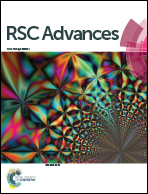A novel BiVO3/SnO2 step S-scheme nano-heterojunction for an enhanced visible light photocatalytic degradation of amaranth dye and hydrogen production
Abstract
The destruction of toxic pollutants and production of hydrogen gas on the surface of semiconductors under light irradiation is the main significance of photocatalysis. Heterojunctions with matching in band gap energy are urgently required for enhancing the redox power of the charge carriers. A step S-scheme BiVO3/SnO2 nano-heterojunction was carefully synthesized for a successful photodegradation of amaranth dye and photocatalytic hydrogen evolution. Tetragonal SnO2 nanoparticles of 80 m2 g−1 surface area and distinct mesoporous structure were fabricated by a sol–gel route in the presence of Tween-80 as the pore structure directing agent. BiVO3 nanoparticles were deposited homogeneously on the SnO2 surface in an ultrasonic bath of power intensity 300 W. The photocatalytic efficiency in the destruction of amaranth dye soar with increasing BiVO3 contents of up to 10 wt%. The hydrogen evolution rate reached 8.2 mmol g−1 h−1, which is eight times stronger than that of pristine SnO2. The sonicated nanocomposites were investigated by XRD, BET, FESEM, HRTEM, EDS, DRS and PL techniques. The step S-scheme heterojunction with superior oxidative and reductive power is the primary key for the exceptional photocatalytic process. The PL of terephthalic acid and the scavenger trapping experiments reveal the charge migration through the step S-scheme mechanism rather than the type (II) heterojunction mechanism.



 Please wait while we load your content...
Please wait while we load your content...